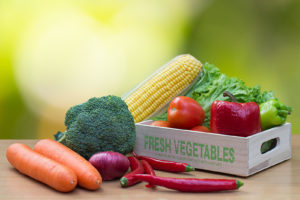
Brightly Colored Vegetables Can Slow Progression of AMD
Our eyes age just like any other part of the body. However, sight is something we rely on to do pretty much anything in life, so this slow descent into worsened vision can be a blow. Poor vision can affect your performance at work. It can affect the way you do your favorite activities. And, it can leave you with a feeling of overall frustration. A lot of this decline is sadly related to age-related macular degeneration (AMD). So, what can you do to slow the progression of AMD?
The good news is that a study recently published in the journal Biochemistry Research International demonstrated that the old wives’ tale of brightly colored veggies improving eyesight is, well, true in a sense. They found that eating a diet rich in antioxidants drastically decreases your risk of AMD, and which foods tend to have the most antioxidants? Brightly colored vegetables!
It’s never too late to listen to your mom and start eating your vegetables.
What Is AMD?
According to the NIH, nearly 5.44 million people are projected to develop AMD by 2050. Since this issue is so prevalent, and will only become more so, it’s important that you understand just exactly what this issue is.
Age-related macular degeneration is just as it sounds: it is the natural aging process of your eye. More specifically, AMD affects the macula part of your eye. The macula is a tiny part of the retina, but it is an essential part. This segment is the part of your eye that allows you to read fine print or thread a needle. It’s kind of like a natural zooming lens.
AMD is caused by the build-up of drusen deposits (made up of lipids and fatty proteins) under the retina. As a result, if left untreated AMD may cause loss of central vision. This makes normal activities like driving, reading, and watching TV more difficult, especially as the disease progresses. That being said, AMD does not affect your peripheral vision.
It is very unlikely that AMD alone would cause total blindness. But, if left untreated, it can lead to blurred and lost central vision, making it difficult to recognize faces or to see objects at a distance.
Carotenoids and Slowing the Progression of AMD
 Unless you’re Benjamin Button and are aging in reverse, chances are everyone will be affected by AMD at some point in their lives. The good news is carotenoids, otherwise known as the pigment that gives such foods as carrots and spinach their colors, can slow the process of AMD.
Unless you’re Benjamin Button and are aging in reverse, chances are everyone will be affected by AMD at some point in their lives. The good news is carotenoids, otherwise known as the pigment that gives such foods as carrots and spinach their colors, can slow the process of AMD.
That being said, carotenoids are by no means a cure or method of prevention. But they will help slow the process and keep your eyes healthier, longer. They are some of the best vitamins for AMD. Our bodies turn carotenoids into active Vitamin A. As you know, vitamin A is the best vitamin for the eyes. This nutrient is to the eyes what water is to a plant. Your eyes simply can’t function without it.
Some carotenoids that can’t be turned into Vitamin A are called non-provitamin A carotenoids. Two of the most beneficial for eye health are lutein and zeaxanthin. Even though they can’t be turned into vitamin A, they are still highly important in slowing the progression of AMD. This is because both are antioxidants that are highly concentrated in the macula. Keeping a high diet filled with lutein and zeaxanthin is the optimal way to reduce AMD. You don’t even have to go out of the way to find it either. Some of your favorite foods are guaranteed to be high in these antioxidants. Keep reading to learn which ones to focus on next time you head to the grocery store.
Best Vegetables and How Much to Eat
There is a long list of foods that are packed with carotenoids that are either provitamin or non-provitamin. With such a variety, it’s impossible to not get a good amount of carotenoids into your diet.
Carrots are the first veggies on our list. One of my fondest childhood memories is of my mom telling me to eat my carrots for my eyes. I’m sure many of you have heard the same from your parents, and they weren’t wrong. They may have been a little spotty on the specifics, but carrots are high in carotenoids. Just half a cup of raw carrots a day counts for 184 percent of your required Vitamin A intake. How easy is that?
Next up are dark leafy greens, which include foods like spinach, kale, turnip greens, and mustard greens. Consider freezing and cooking your leafy greens. Freezing condenses the vegetables, heightening the concentration of carotenoids. When cooked from frozen, half a cup of spinach can provide 200 percent of your required daily intake of Vitamin A versus the 56 percent required when cooked fresh. That’s a huge difference!
Sweet potatoes take the cake when it comes to carotenoid contents. Half of one baked sweet potato can provide 400 percent of your needed daily dose of Vitamin A. And no, that’s not a typo. It really is 400 percent. On top of that, sweet potatoes are healthier alternatives to regular high-carb potatoes.
Here are some vegetables that didn’t make the list, but deserve an honorable mention nonetheless:
- Romaine lettuce
- Peas
- Sweet bell peppers
- Broccoli
- Sweet corn
Best Fruits
Not a vegetable person? No problem! Carotenoids are not only found in vegetables, but also in a great number of highly pigmented fruit. Here are some fruits that are equally as beneficial as vegetables:
- Squash (butternut squash, Hubbard squash, pumpkin)
- Cantaloupe
- Oranges
- Peaches
Eye Vitamins and Slowing the Progression of AMD
Vitamin A isn’t the only vitamin you need. Our Ocu-Plus Formula provides you with all the nutrients your eyes need. Of course, with the added high in carotenoid foods, you’ll be seeing better than a hawk well into your old age. There’s a lot you can do to make sure you stave off AMD as long as possible. Subscribing to a healthy diet and supplement regimen is a great first step!
Our Rebuild Your Vision Ocu-Plus Formula Contains All 17 Vitamins, Minerals, and Herbal Supplements to Improve Your Eye Health!












thanks for your guidance
most of us reading this about brightly colored veggies have been unaware of their excellent qualities. Thanks for sharing this knowledge.
thanks so much for information
I am in agreement with your article to encourage people to eat a wide variety, and more fruits and vegetable. However, I want to point out an error in the article which states “On top of that, sweet potatoes are healthier alternatives to regular high-fat potatoes”.
Potatoes, just like sweet potatoes are NOT HIGH IN FAT. They contain neglibile fat. It’s the preparation or finishing of both of these tubers that can add the fat (deep frying, melted butter).